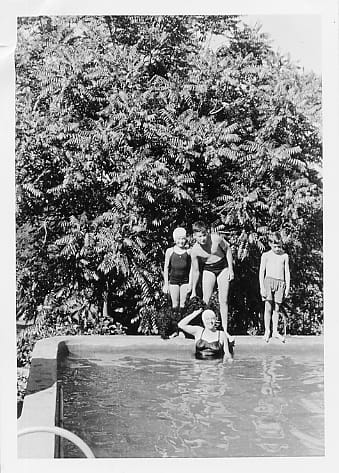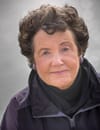Hillandale

Tenderi, Our Hillandale House Swimming Bath 1957. Mom, Diana, Brian and David with Manzi our cocker spaniel
Hillandale
Hillandale, as it’s name implies, was a lovely area just outside of Que Que with lots of ups and downs. It looked onto a range of undisturbed hills, wooded with msasa, mfuti, mnongo and especially mountain acacia trees. In September, before the rains came, these hills turned red and yellow and then the bright new green of spring. Mom and Dad had bought a 20 acre plot there in 1952. It included the trigonometry beacon, the highest point in the area.
Hillandale
Now, in 1956, we were shortly to be without a house. Dad agonized over whether building a house on the plot would be a practical move or not. The hospital was on the opposite side of town, five miles away. Most of the road was unpaved, dusty and corrugated.
“Its too remote,” said Dad.
“The further the better.” said Mom.
Mom prevailed.
Dad set about planning the house, in between the practice and politics. There were terraces of big stone walls half way up the hill, above a circular driveway. In the middle of the driveway stood a big mimosa tree with its thorny crown of yellow pom-poms. The slope was steep above the existing terraces. Mom loved the view of the wooded hills. A view, Dad always claimed, elevated thoughts above everyday strife to another plain altogether. How high could they build?
Dad sited the house above the terraces just before the slope became impossibly steep. We could see the hills stretching all the way from the steel works ten miles to the south west and far to the north. We would leave the bush above the house intact. Once in a while we could spot monkeys on Taylors Hill a mile away. There were all sorts of birds. Our next door neighbor had shot a leopard just the year before, much to Mom’s sorrow. It felt as if we owned the world then, although a walk along a path through the bush brought us to a water tower, which we could climb for another view. It overlooked Amaveni Township, which housed about 5000 Natives. Our isolation was an illusion but for us it was a “Shangri-La”. It never occurred to us to worry about security.
Mr. Mc. Gaw took an afternoon off work at the mine to survey and stake out the site.
Popular Mechanics was the “in” magazine. We even acquired back issues and pored over every one.
We would auction off all the old furniture we had inherited from Dr. Zacks when we had moved to #1 Silver Oaks Road the decade before. Everything would be new and modern. Built in cupboards were the new thing: pass through cupboards the state of the art.
Dad designed pass-though cupboards between the kitchen and the dining room to minimize the intrusion of the servants. A similar unit was designed between the laundry and passage to the bedrooms. Mr. Lucky, “a true craftsman” would build them out of indigenous hardwoods.
Graph paper became rough and worn as we designed and redesigned, in the midst of the excitement over our new farm.
Mom meanwhile was designing the most important part of the house. We would be so far from town after all. She insisted on priorities. The swimming bath needed to be put in first. It would be invaluable when tempers were frayed in suicide month, October, before the rains came, and the house build was in progress.
Mom prevailed.
Below you can see a map of the exact location of the Hillandale house as well as a lot of other Que Que sites identified in collaboration with Aaron and Morris Sloman.
View Map of Que Que/Kwe Kwe (Southern Rhodesia) in a larger map
